Cryptostephanus
Cryptostephanus Welw. ex Baker
Family: Amaryllidaceae
Common names: none known
Introduction
Cryptostephanus is a curious, little-known genus comprising three species from Namibia, Angola, Zimbabwe, Mozambique, Tanzania and Kenya. It is most closely related to Clivia, and the flowers are remarkable in having a partially hidden, crown-like structure composed of 6 or 12 narrow appendages.

Description
Description
Cryptostephanus species are solitary or sometimes clump-forming perennials, and all have rhizomatous rootstocks with well developed, fleshy roots that are sometimes tuberous in the lower part (C. haemanthoides). They have dark green or intensely glaucous (greenish grey), strap-shaped leaves produced in two opposite rows from an erect pseudostem, and are either evergreen (C. vansonii) or deciduous and summer-growing (C. densiflorus, C. haemanthoides).
The peduncle (flower stem) is laterally compressed, with two sharp, longitudinal ridges, and bears sparse or dense pseudo-umbels (flower heads) of white, light pink, maroon, brownish or purplish maroon, tubular flowers, with short or long, straight or curved, perianth tubes. The flowers have suberect, spreading or recurved tepals and are characterized in having a partially hidden, crown-like structure (a corona) consisting of 6 or 12 narrow appendages attached to the inner tip of the perianth tube. There are 6 stamens which are included within the perianth tube or slightly protruding. The inferior ovary is round and the straight, erect, white style is included within the perianth tube or slightly protruding, with a flattened, head-like stigma.

The fruit is a round, shiny or matt, bright red or pinkish red, fleshy berry containing hard, egg-shaped or more or less round, white, fleshy seeds, surrounded by a thin phytomelanous coat (a brown, or blackish brown organic, crust-like covering). The basic chromosome number for Cryptostephanus is x = 12.

Conservation Status
Status
None of the Cryptostephanus species have been formally assessed, but it is likely that none are threatened, due to their occurrence in mostly inaccessible terrain.
Distribution and habitat
Distribution description
Cryptostephanus densiflorus is native to the Kaokoveld Centre of Endemism in the northwestern corner of Namibia and the extreme southwestern part of Angola. It occurs in deciduous woodland (Ernst van Jaarsveld personal communication) and is nowhere very common, growing as occasional solitary individuals or in small groups in openings between trees and shrubs in full sun, usually in sandy soil between rock slabs. The plants receive plentiful summer rainfall but undergo a very dry winter dormant period.
C. vansonii is endemic to the Eastern Highlands of Zimbabwe in the cool, moist forests of the Vumba and southern Chimanimani Mountains, and to the adjacent forests of western Mozambique. It grows in colonies in decomposing leaf litter amongst rocks on the forest floor, in deep shade.
C. haemanthoides is the most widespread species and has a disjunct distribution. It occurs in southern Kenya, is widespread across Tanzania, and is also recorded from southwestern Angola; it could possibly also occur in Zambia and in the southern Democratic Republic of Congo. Its habitat is variable, including grassland in full sun, in sandy or clay soils, as well as in dappled shade on rocky slopes near rivers and in forested gorges, usually between, or occasionally upon, granite boulders (lithophytic).
Derivation of name and historical aspects
History
The generic name Cryptostephanus is derived from the Greek words kryptós (hidden), and stephanus (a crown), and is descriptive of the partially hidden, crown-like structure of linear appendages attached to the inner tip of the perianth tube.
The first known member of the genus was C. densiflorus, found in January 1860 by the Austrian medic, explorer and botanist, Dr Friedrich M.J. Welwitsch (1806–1872) of Welwitschia fame. He collected it in the mountains of Huíla Province in the temperate southwestern region of Angola, and it was described by the Kew botanist J.G. Baker in volume 7 of the Journal of Botany, in 1878. The specific name densiflorus is derived from the Latin words densus (meaning crowded) and florus (meaning flower) and is descriptive of the sometimes dense arrangement of flowers on the flower head.
The second species to be described was C. haemanthoides, found in February1877 by the German explorer J.M. Hildebrandt (1847–1881) southeast of Tsavo National Park in southern Kenya, and described by the German botanist Ferdinand Pax in volume 15 of Botanische Jahrbücher, in 1893. The specific name haemanthoides is derived from the Greek haima (blood) and -oides (resembling), alluding to the haemanthus-like shape of the flower head.
The third species, C. vansonii, was first collected in the early 1940’s by the Russian naturalist Georges van Son in the Vumba Mountains of eastern Zimbabwe. He grew the plant in his garden in Pretoria where it flowered and was later described by the South African botanist Dr Inez Verdoorn in volume 23 of The Flowering Plants of South Africa, in 1943. The specific name vansonii is the Latinized version of the discoverer’s name.
Within the family Amaryllidaceae, Cryptostephanus belongs to the tribe Haemanthae, which includes the genera Apodolorion, Clivia, Gethyllis, Haemanthus and Scadoxus. Together with Clivia and Scadoxus, Cryptostephanus is one of only three genera in the African Amaryllidaceae which does not have a true bulb, but a rhizomatous rootstock.
There are three species of Cryptostephanus and they are most closely related to Clivia, an evergreen genus with similar perennial fleshy roots, strap-shaped leaves produced in opposite ranks from a pseudostem, a similar laterally compressed peduncle, and mostly tubular flowers with fleshy berries and hard, fleshy seeds.
Ecology
Ecology
Cryptostephanus densiflorus and C. haemanthoides are deciduous, summer-growing plants which are dormant in winter, whereas C. vansonii is evergreen. Flowering takes place from October to March. The flowers of C. vansonii are strongly self-fertile in cultivation, readily setting seed in enclosed, insect-free conditions. The long-tubed flowers of C. haemanthoides are self-sterile and very short-lived, remaining fully open for no more than one day (Adam Harrower personal communication). The curved flowers of C. densiflorus are also self-sterile and contain small amounts of nectar in their inflated bases, indicating a possible adaptation to bird pollination. They are also short-lived, individual flowers barely lasting three days before dropping off. The red or pinkish red fleshy berries of Cryptostephanus take up to nine months to mature and are probably eaten and dispersed by birds and monkeys.
Uses
Use
Cryptostephanus has no cultural or magical uses, but it is used to a limited extent as a container plant by specialist bulb-growers; C. vansonii is the most commonly grown species. Cryptostephanus densiflorus and C. haemanthoides are extremely rare in cultivation.
Growing Cryptostephanus
Grow
All Cryptostephanus species require a frost-free environment and the evergreen C. vansonii is the most easily cultivated member, performing very well in light or deep shade. Plant the rootstocks in decomposing organic matter such as acidic leaf mould, or a mixture of equal parts of acidic composted bark and coarse grit. They are ideally suited to containers and also grow well outdoors in mild climates, such as in the southern suburbs of Cape Town, provided it has sufficient shade and a very well-drained growing medium. Potted plants only need one heavy watering every two weeks and must not be kept constantly wet. In ideal conditions it is a long-lived plant, lasting 30 years or more, and forms occasional offsets.
C. densiflorus performs fairly well in containers in a sharply drained medium consisting of grit and coarse river sand mixed in equal proportion, with a layer of well-rotted compost placed at the base of the container. It likes a 20–25 cm diameter container, with the top of the rhizome placed just below soil level. The rootstock is extremely sensitive to over-watering; at the beginning of the growing season in early summer, apply an initial drench, and once the leaf shoots appear within two to three weeks, apply a weekly drench until the end of summer. When the leaves begin to turn yellowish brown, gradually decrease drenching to once fortnightly, and finally withhold moisture altogether once the leaves have almost fully desiccated. Do not store the rootstock bare-rooted over the dormant period but leave it in its dry medium until the onset of new growth in early summer. This species does not form offsets.
C. haemanthoides is the most difficult species to grow. The most commonly encountered problem is rotting of the rhizome and fleshy roots due to over-watering in summer, and to excessive desiccation during the winter-dormant months. Depending on the origin of the form being grown, place C. haemanthoides rhizomes in a lightly shaded or sunny place and plant in a 20–25 cm diameter container in an acid medium such as equal parts of composted bark mixed with coarse grit. Follow the same watering procedure for C. densiflorus (see above), but bear in mind that C. haemanthoides plants go dormant earlier, usually in mid-summer, and begin growth earlier, usually in late winter. The plants are usually solitary but may occasionally form offsets.
Seeds of C. haemanthoides germinate fairly easily within a couple of months but seedlings are susceptible to damping-off fungi (Adam Harrower personal communication). Seeds of C. vansonii are notoriously slow to germinate, and nothing is known about germinating seeds of C. densiflorus. Remove the outer red, fleshy layer from the ripe berries to obtain the seeds. Place the seeds onto the surface of a well-aerated medium such as equal parts of composted bark and coarse grit in deep pots or seed trays and half-cover with the same medium. Using a watering can with a fine rose, water with a contact fungicide and keep the medium slightly moist but not wet. Seeds of C. vansonii can also be sown this way but may take many months to germinate; alternatively, allow the seeds of this species to germinate within the ripe fruits, while still attached to the ovary wall, then remove seedlings and pot-up individually. The juvenile period for C. vansonii is three to four years in ideal conditions, but is unknown for C. haemanthoides and C. densiflorus. Once well established, leave cryptostephanus plants undisturbed for at least five years before re-potting. Offsets of C. vansonii are best separated and replanted in spring.
The leaf upper surfaces of all three species are susceptible to infestation by red spider mites in warm, enclosed, greenhouse conditions, so place the plants in a well-ventilated area. The tunics surrounding the rhizomes sometimes become infested with mealy bugs, and the leaf margins are sometimes chewed by snout beetles.
Species
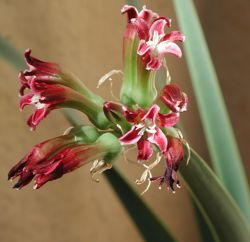
Cryptostephanus densiflorus Welw. ex Baker
Plants deciduous, summer-growing, up to 680 mm high; leaves 6–8, erect or suberect, intensely glaucous, channelled, slightly spirally twisted in upper part.
Flower head 9–30-flowered, hemispherical; perianth tube curved when fully developed, 8–12 mm long; flowers nodding or pendulous, maroon or purplish maroon; tepals recurved; stamens and style included within perianth tube; corona consisting of 12 appendages; seeds round. Flowering time: October to February.
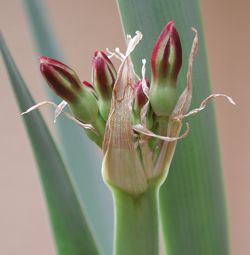
Cryptostephanus densiflorus Welw. ex Baker
Illustration shows buds about to open.

Cryptostephanus haemanthoides Pax
Plants deciduous, summer-growing, up to 500 mm high; roots tuberous in lower part; leaves 8–15, suberect or recurved, intensely glaucous or dark green, slightly or deeply channelled, sometimes spirally twisted in upper part.
Flower head 30–100-flowered, spherical when fully open; perianth tube straight, 20 mm long; flowers radiating, brownish or purplish maroon; tepals spreading or recurved; stamens and style exserted beyond perianth tube; corona consisting of 12 appendages; seeds more or less round, with a light brown phytomelanous covering. Flowering time: December to March.
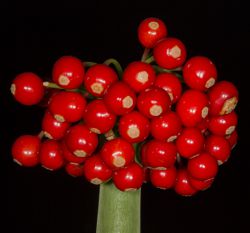
Cryptostephanus haemanthoides Pax.
Illustration shows stalk with ripe berries.
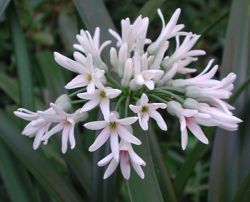
Cryptostephanus vansonii I.Verd.
Plants evergreen, up to 750 mm high; leaves 10–16, recurved, dark green, slightly or moderately channelled; roots covered with a corky, white velamen (multiple layers of dead cells).
Flower head 15–40-flowered, hemispherical; perianth tube straight, 4–7 mm long; flowers white, sometimes pink-tinged; tepals spreading or suberect; stamens and style included within perianth tube; corona consisting of 6 appendages; seeds egg-shaped with a blackish brown, phytomelanous covering. Flowering time: mainly October to November, or sporadically at any time of year.
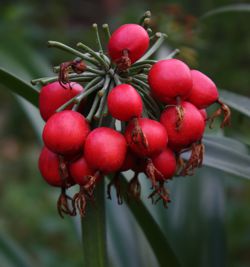
Cryptostephanus vansonii I.Verd. showing berries.
References
- Baker, J.G. 1878. On the new Amaryllidaceae of the Welwitsch and Schweinfurth Expeditions. Journal of Botany (New Series) 7: 193, 194.
- Duncan, G.D. 2002. Cryptostephanus vansonii, a curious amaryllid from Zimbabwe. Veld & Flora 88(1): 18, 19.
- Duncan, G.D. 2008. Grow clivias. Kirstenbosch Gardening Series. South African National Biodiversity Institute, Cape Town.
- Duncan, G.D. 2010a. Cryptostephanus densiflorus. Curtis’s Botanical Magazine 27 (1): 10–22.
- Duncan, G.D. 2010b. The genus Cryptostephanus Welw. ex Baker. Herbertia 64: 136–149.
- Duncan, G.D. 2010c. Grow bulbs. Kirstenbosch Gardening Series. South African National Biodiversity Institute, Cape Town.
- Meerow, A.W. & Clayton, J.R. 2004. Generic relationships among the baccate-fruited Amaryllidaceae (tribe Haemantheae) inferred from plastid and nuclear non-coding DNA sequences. Plant Systematics & Evolution 244: 141–155.
- Pax, F.A. 1893. Amaryllidaceae africanae. Cryptostephanus Welw. In A. Engler,Botanische Jahrbücher 15: 142, 143.
- Verdoorn, I.C. 1943. Cryptostephanus vansonii. The Flowering Plants of South Africa 23: t. 885.
Credits
Graham Duncan
Kirstenbosch National Botanical Garden
June 2015
Plant Attributes:
Plant Type:
SA Distribution:
Soil type:
Flowering season:
PH:
Flower colour:
Aspect:
Gardening skill:
Special Features:
Horticultural zones






Rate this article
Article well written and informative
Rate this plant
Is this an interesting plant?
Login to add your Comment
Back to topNot registered yet? Click here to register.